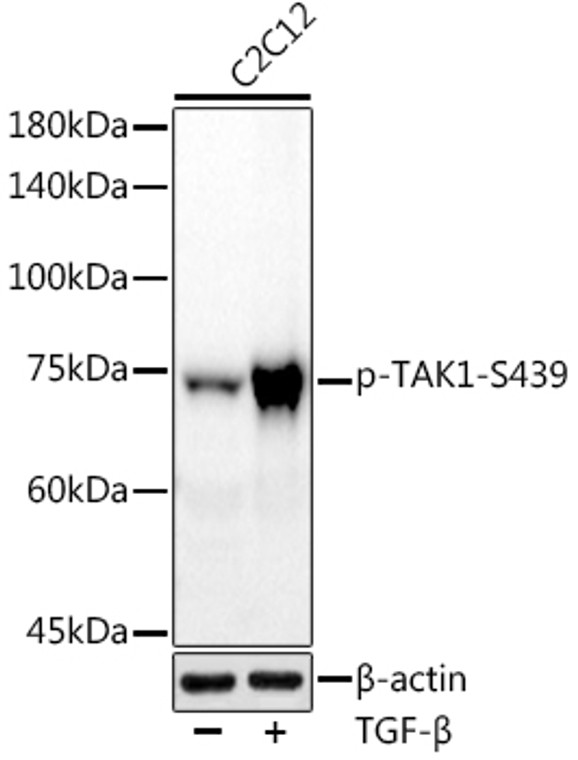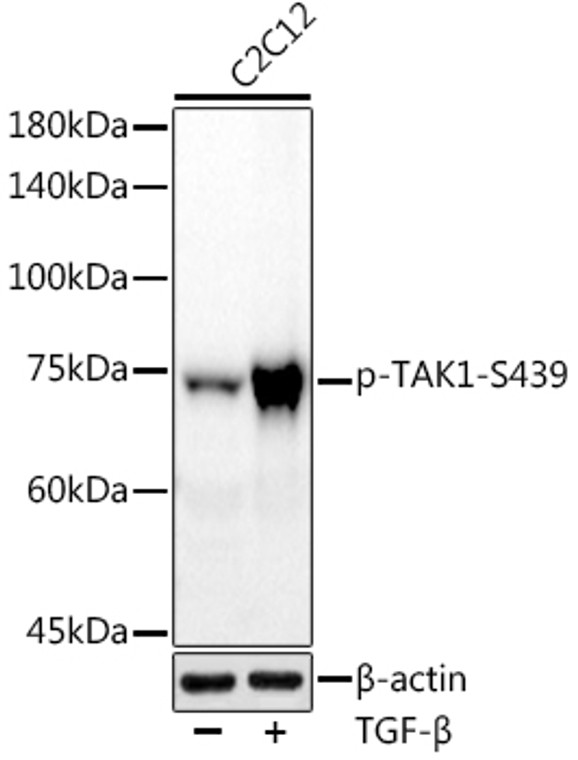| Host: |
Rabbit |
| Applications: |
WB |
| Reactivity: |
Mouse |
| Note: |
STRICTLY FOR FURTHER SCIENTIFIC RESEARCH USE ONLY (RUO). MUST NOT TO BE USED IN DIAGNOSTIC OR THERAPEUTIC APPLICATIONS. |
| Short Description: |
Rabbit monoclonal antibody anti-Phospho-TAK1-S439 is suitable for use in Western Blot research applications. |
| Clonality: |
Monoclonal |
| Clone ID: |
S9MR |
| Conjugation: |
Unconjugated |
| Isotype: |
IgG |
| Formulation: |
PBS with 0.02% Sodium Azide, 0.05% BSA, 50% Glycerol, pH7.3. |
| Purification: |
Affinity purification |
| Dilution Range: |
WB 1:500-1:1000 |
| Storage Instruction: |
Store at-20°C for up to 1 year from the date of receipt, and avoid repeat freeze-thaw cycles. |
| Gene Symbol: |
MAP3K7 |
| Gene ID: |
6885 |
| Uniprot ID: |
M3K7_HUMAN |
| Immunogen: |
A synthetic phosphorylated peptide around S439 of human TAK1 (O43318). |
| Immunogen Sequence: |
RRSIQ |
| Tissue Specificity | Isoform 1A is the most abundant in ovary, skeletal muscle, spleen and blood mononuclear cells. Isoform 1B is highly expressed in brain, kidney and small intestine. Isoform 1C is the major form in prostate. Isoform 1D is the less abundant form. |
| Post Translational Modifications | Association with TAB1/MAP3K7IP1 promotes autophosphorylation at Ser-192 and subsequent activation. Association with TAB2/MAP3K7IP2, itself associated with free unanchored Lys-63 polyubiquitin chain, promotes autophosphorylation and subsequent activation of MAP3K7. Dephosphorylation at Ser-192 by PPM1B/PP2CB and at Thr-187 by PP2A and PPP6C leads to inactivation. 'Lys-48'-linked polyubiquitination at Lys-72 is induced by TNFalpha, and leads to proteasomal degradation. Undergoes 'Lys-48'-linked polyubiquitination catalyzed by ITCH. Requires 'Lys-63'-linked polyubiquitination for autophosphorylation and subsequent activation. 'Lys-63'-linked ubiquitination does not lead to proteasomal degradation. Deubiquitinated by CYLD, a protease that selectively cleaves 'Lys-63'-linked ubiquitin chains. Deubiquitinated by Y.enterocolitica YopP. (Microbial infection) Cleaved and inactivated by the proteases 3C of coxsackievirus A16 and human enterovirus D68, allowing the virus to disrupt TRAF6-triggered NF-kappa-B induction. (Microbial infection) Acetylation of Thr-184 and Thr-187 by Yersinia YopJ prevents phosphorylation and activation, thus blocking the MAPK signaling pathway. |
| Function | Serine/threonine kinase which acts as an essential component of the MAP kinase signal transduction pathway. Plays an important role in the cascades of cellular responses evoked by changes in the environment. Mediates signal transduction of TRAF6, various cytokines including interleukin-1 (IL-1), transforming growth factor-beta (TGFB), TGFB-related factors like BMP2 and BMP4, toll-like receptors (TLR), tumor necrosis factor receptor CD40 and B-cell receptor (BCR). Once activated, acts as an upstream activator of the MKK/JNK signal transduction cascade and the p38 MAPK signal transduction cascade through the phosphorylation and activation of several MAP kinase kinases like MAP2K1/MEK1, MAP2K3/MKK3, MAP2K6/MKK6 and MAP2K7/MKK7. These MAP2Ks in turn activate p38 MAPKs and c-jun N-terminal kinases (JNKs).both p38 MAPK and JNK pathways control the transcription factors activator protein-1 (AP-1). Independently of MAP2Ks and p38 MAPKs, acts as a key activator of NF-kappa-B by promoting activation of the I-kappa-B-kinase (IKK) core complex. Mechanistically, recruited to polyubiquitin chains of RIPK2 and IKBKG/NEMO via TAB2/MAP3K7IP2 and TAB3/MAP3K7IP3, and catalyzes phosphorylation and activation of IKBKB/IKKB component of the IKK complex, leading to NF-kappa-B activation. In osmotic stress signaling, plays a major role in the activation of MAPK8/JNK1, but not that of NF-kappa-B. Promotes TRIM5 capsid-specific restriction activity. Phosphorylates RIPK1 at 'Ser-321' which positively regulates RIPK1 interaction with RIPK3 to promote necroptosis but negatively regulates RIPK1 kinase activity and its interaction with FADD to mediate apoptosis. |
| Protein Name | Mitogen-Activated Protein Kinase Kinase Kinase 7Transforming Growth Factor-Beta-Activated Kinase 1Tgf-Beta-Activated Kinase 1 |
| Database Links | Reactome: R-HSA-1169091Reactome: R-HSA-168638Reactome: R-HSA-202424Reactome: R-HSA-2871837Reactome: R-HSA-4086398Reactome: R-HSA-445989Reactome: R-HSA-450302Reactome: R-HSA-450321Reactome: R-HSA-5357956Reactome: R-HSA-5607764Reactome: R-HSA-5689880Reactome: R-HSA-9014325Reactome: R-HSA-9020702Reactome: R-HSA-937042Reactome: R-HSA-937072Reactome: R-HSA-9645460Reactome: R-HSA-9705671Reactome: R-HSA-975163 |
| Cellular Localisation | CytoplasmCell MembranePeripheral Membrane ProteinCytoplasmic SideAlthough The Majority Of Map3k7/Tak1 Is Found In The CytosolWhen Complexed With Tab1/Map3k7ip1 And Tab2/Map3k7ip2It Is Also Localized At The Cell Membrane |
| Alternative Antibody Names | Anti-Mitogen-Activated Protein Kinase Kinase Kinase 7 antibodyAnti-Transforming Growth Factor-Beta-Activated Kinase 1 antibodyAnti-Tgf-Beta-Activated Kinase 1 antibodyAnti-MAP3K7 antibodyAnti-TAK1 antibody |
Information sourced from Uniprot.org
12 months for antibodies. 6 months for ELISA Kits. Please see website T&Cs for further guidance








